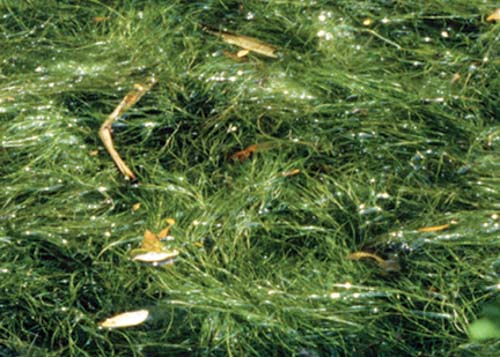Sago Pondweed
Sago pondweed (Potamogeton pectinatus) is some of the first grass to appear in spring. Fish it with a rattle-trap, big swim bait or Carolina rig that will float just above emerging plants.

Seasonal Techniques
Spring—Like most native annual plants, sago pondweed will begin to emerge in late April or early May. Being some of the first grass to emerge, you can find sago pondweed and fish new, growing plants before other plants have even sprouted. Try a rattle-trap, big swim bait or Carolina rig that will float just above emerging plants. These plants grow in clumps, so fishing open areas between plants is a good bet.
Summer—Like others, sago pondweed will increase growth and begin to top out during summer. Reaching the surface, the plant will begin to flower and continue to bloom through fall. The brittle nature of the plant makes punching easy.
Fall—Competition for space with invasive plants will leave sago pondweed confined to shallow depths and areas void of other species. Sago pondweed will begin dying back earlier so these mats will be some of the first to go, opening up space between other plants. Look for these brown spots and fish them while other plants are still actively growing and hard to fish.
Winter—Sago pondweed will die completely back, leaving only seed behind so there's no need to target this species during winter.
Habitat Value
Fish—The growth habit of sago pondweed lends it to being productive habitat for fish.
Waterfowl—Waterfowl extensively use and rely on sago pondweed as food and the whole plant can be consumed; parts are utilized by diving, dabbling, whistling ducks, many types of geese, swans and coots.
Identifying Features
What It Looks Like—Like other pondweeds, leaves are alternating and submersed. Sago pondweed appears “bushy” where leaves come together, almost resembling a pom-pom.
Where to Find It—Sago pondweed can be found in a wide variety of places. In areas where invasive plants like hydrilla and milfoil aren’t present, this plant can do well. Look in shallow areas with good current flow.
Max Depth—6 feet
Similar Species: Slender pondweed, southern naiad.
Drawbacks
Sago pondweed can grow to nuisance levels. Cost to manage: $$ out of $$$$$.
Contact Us
We're always looking for more information about aquatic plants on TVA reservoirs. Let us know where and what you see, and send us your photos. Email us.